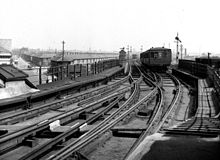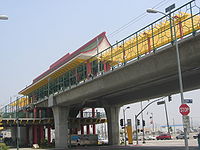Elevated railway Contents History Systems Modern systems Proposed designs Image gallery See also References Navigation menu"DLR History Timeline"."Where are the drivers?"HistoryPopular Science says Tubular Rail high speed train right for America's crumbling infrastructure
Railways by type
rapid transittracksbroad gaugestandard gaugenarrow gaugelight railmonorailsuspension railwaylevel crossingsLondon and Greenwich Railwaybrick viaductLondon and Blackwall RailwayWest Side and Yonkers Patent Railwaycable carsManhattan RailwaySouth Side Elevated RailroadBoston Elevated RailwayChicago transit systemBerlin StadtbahnVienna StadtbahnLiverpool Overhead RailwayDocklands Light RailwayYurikamomemonorailsDisneyland Monorail SystemTokyo MonorailSydney MonorailKL MonorailLas Vegas MonorailSão Paulo Monorailmaglevsuspension railwaysSchwebebahn DresdenWuppertal SchwebebahnH-BahnDortmundDüsseldorf airportMemphis Suspension RailwayShonan MonorailChiba Urban MonorailBombardier Innovia APMPHX Sky TrainAeroTrainLondon Gatwick AirportChicago "L"Market FrankfordWest PhiladelphiaChinatownLos AngelesLine 15 monorailSao PauloU2 trainBerlinPrenzlauer BergHochbahnHamburgLandungsbrückenU1 stationMuggenhofNurembergCambronneMétro Line 6Paris7 trainNew York CityDocklands Light RailwayLondonKolkata Suburban RailwayChennai MRTSEDSA LRT stationLRT Line 1Metro VancouverSkyTrainNew WestminsterBritish ColumbiaLas Vegas MonorailLas Vegas

Liverpool Overhead Railway, May 1951.

NS 93 train on an elevated portion of the line 5 of the Santiago Metro.

Two Wuppertal Schwebebahn trains meet above street
An elevated railway (also known as an El rail, El train or simply an El for short, and, in Europe, as an overhead railway) is a rapid transit railway with the tracks above street level on a viaduct or other elevated structure (usually constructed of steel, concrete, or brick). The railway may be broad gauge, standard gauge, narrow gauge, light rail, monorail, or a suspension railway. Elevated railways are usually used in urban areas where there would otherwise be a large number of level crossings. Most of the time, the tracks of elevated railways that run on steel viaducts can be seen from street level.
Contents
1 History
2 Systems
2.1 Monorail systems
2.2 Suspension railways
2.3 People mover systems
3 Modern systems
3.1 Full Metro System
3.2 People mover
4 Proposed designs
5 Image gallery
6 See also
7 References
History
The earliest elevated railway was the London and Greenwich Railway on a brick viaduct of 878 arches, built between 1836 and 1838. The first 2.5 miles (4.0 km) of the London and Blackwall Railway (1840) was also on a viaduct. During the 1840s there were other schemes for elevated railways in London that did not come to fruition.[1]
From the late 1860s onward elevated railways became popular in US cities. The New York West Side and Yonkers Patent Railway operated with cable cars from 1868 to 1870, thereafter locomotive-hauled. This was followed by the Manhattan Railway in 1875, the South Side Elevated Railroad, Chicago (1892–), and the elevated lines of the Boston Elevated Railway (1901–). The Chicago transit system itself is known as "L", short for "elevated". The Berlin Stadtbahn (1882) and the Vienna Stadtbahn (1898) are also mainly elevated.
The first electric elevated railway was the Liverpool Overhead Railway, which operated through Liverpool docks from 1893 until 1956.
In London, the Docklands Light Railway is a modern elevated railway that opened in 1987 and, since, has expanded.[2] The trains are driverless and automatic.[3]
Another modern elevated railway is Tokyo's driverless Yurikamome line, opened in 1995.[4]
Systems
Monorail systems
Most monorails are elevated railways, such as the Disneyland Monorail System (1959), the Tokyo Monorail (1964), the Sydney Monorail (1988–2013), the KL Monorail, the Las Vegas Monorail, and the São Paulo Monorail. Many maglev railways are also elevated.
Suspension railways
During the 1890s there was some interest in suspension railways, particularly in Germany, with the Schwebebahn Dresden, (1891–) and the Wuppertal Schwebebahn (1901). H-Bahn suspension railways were built in Dortmund and Düsseldorf airport, 1975. The Memphis Suspension Railway opened in 1982.
The Shonan Monorail and the Chiba Urban Monorail in Japan, despite their names, are suspension railways too.
Suspension railways are usually monorail.
People mover systems

H-Bahn Dortmund, a monorail suspension people mover
People mover or automated people mover (APM) is a type of driverless grade-separated, mass-transit system. The term is generally used only to describe systems that serve as loops or feeder systems, but is sometimes applied to considerably more complex automated systems. Similar to monorails, Bombardier Innovia APM technology uses only one rail to guide the vehicle along the guideway. APMs are common at airports and effective at helping passengers quickly reach their gates. Several elevated APM systems at airports including the PHX Sky Train at Phoenix Sky Harbor International Airport; AeroTrain at Kuala Lumpur International Airport; and the Tracked Shuttle System at London Gatwick Airport, United Kingdom.
Modern systems
Full Metro System

Traffic on Roosevelt Avenue in Jackson Heights, New York City, under the elevated IRT Flushing Line (used by the 7 and <7> trains) in the 1980s
Berlin U-Bahn (U1 and U2 lines)
Chicago "L" (except for parts of the Red Line and Blue Line)- Copenhagen Metro
Hamburg U-Bahn (U3 line)
Lahore Metro (Orange Line)- Manila Light Rail Transit System
- Miami Metrorail
New York City Subway (partial)- Philadelphia's Market–Frankford Line (underground in downtown Philadelphia and West Philadelphia up to 40th Street Station but elevated elsewhere)
- Rapid Metro Gurgaon
Line 3 Scarborough, a medium capacity metro rail line in Toronto, Ontario, Canada
BTS Skytrain, two elevated rapid transit lines in Bangkok, Thailand
SkyTrain, Vancouver, British Columbia, Canada.
Vienna U-Bahn (U6 line)
Wenhu line, Taipei, Taiwan- Wuppertal Suspension Railway
Disused:
Boston Elevated Railways - Atlantic Avenue Elevated, Charlestown Elevated, Washington Street Elevated, Causeway Street Elevated- Elevated railways operated by the Interborough Rapid Transit Company and Brooklyn Rapid Transit Company in New York City
- Liverpool Overhead Railway
People mover
AirTrain JFK, a people mover at and around John F. Kennedy International Airport, New York City, New York, United States
ATL Skytrain, a people mover at Hartsfield–Jackson Atlanta International Airport, Atlanta, Georgia, United States
Changi Airport Skytrain, an inter-terminal people mover at Changi International Airport in Singapore
Detroit People Mover, an urban transit people mover in Detroit, Michigan, United States
H-Bahn, an inter-terminal automated people mover in Dortmund and Dusseldorf, Germany
MIA Mover, a people mover at Miami International Airport, Miami, Florida, United States
PHX Sky Train, a people mover at Phoenix Sky Harbor International Airport, Phoenix, Arizona, United States
Proposed designs
Tubular Rail, trackless elevated train.[5]
UC San Diego Blue Line extension will mostly be aerial light rail.
Image gallery
Skytrain

Chicago "L" Green Line train in Downtown Chicago.

Market Frankford train in West Philadelphia, Pennsylvania

Chinatown station in Los Angeles, California

Line 15 monorail, Sao Paulo, Brazil

A U2 train in Berlin-Prenzlauer Berg
Hochbahn at Hamburg Landungsbrücken

U1 station Muggenhof in Nuremberg

Cambronne station on Métro Line 6 in Paris

A 7 train in New York City, New York

Elevated section of the Docklands Light Railway in London

Bimanbandar station of the Kolkata Suburban Railway
Thiruvanmiyur station of the Chennai MRTS

A 3rd generation train heading to EDSA LRT station of LRT Line 1

Metro Vancouver's SkyTrain system is mostly elevated, New Westminster, British Columbia, Canada
Las Vegas Monorail, Las Vegas, Nevada
See also
Bombardier Innovia family of automated rapid transit systems (elevated technologies - Monorail, APM, Metro)- Elevator
- Grade separation
- Monorail
- Railway
- Rapid transit
- People mover
- Trackless
References
^ Jack Simmons and Gordon Biddle, The Oxford Companion to British Railway History, Oxford University Press, (1997), p.360.
^ "DLR History Timeline". Transport for London.
^ "Where are the drivers?" Transport for London.
^ New Transit Yurikamome website History Retrieved 3 March 2015
^ Popular Science says Tubular Rail high speed train right for America's crumbling infrastructure















